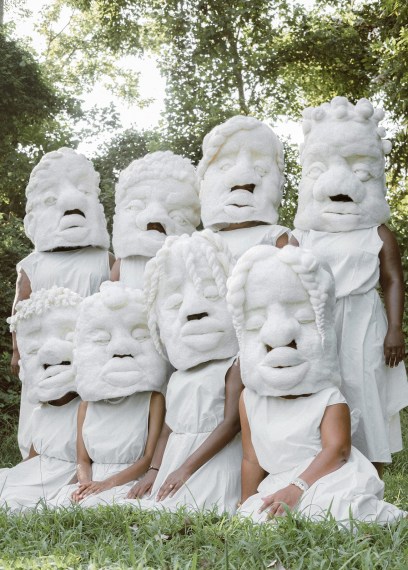Making SPACES

By Amanda Koehn
Starting a new role, in a new city leading a 43-year-old arts organization during a once-in-a-century pandemic and amid a reinvigorated societal reckoning with racism and social issues may seem daunting.
But to both Tizziana Baldenebro, SPACES’ 33-year-old new executive director, and the organization itself, it’s an opportunity to try to do better.
To Baldenebro, that means making the arts organization more inviting to all, having hard conversations about the intersection of the international artists SPACES engages and the local Cleveland community, and understanding the many dynamics at play in creating a more equitable future.

“I think there is something very radical about post-industrial landscapes,” says Baldenebro, who arrived at SPACES in August 2020 after about a year as Ford Curatorial Fellow at the Museum of Contemporary Art Detroit. “I’ve written a bit about how it does feel like things are possible here in a way that they don’t feel possible in a coastal city, sort of like major art centers. And there’s a real, sincere opportunity to envision an artscape that is equitable, that is actually challenging culturally,” she says.
But for Baldenebro and the contemporary arts organization as a whole, expanding equity and helping produce and show work that addresses some of the most difficult issues of our time involves questioning long-held functions at the root, and asking, what audiences are being served?
New leader, an ever-evolving mission
SPACES functions as a gallery space and a resource and public forum for artists “who explore and experiment,” according to its mission statement. It commissions artists from around the world to develop work that responds to current issues. Around the featured artists’ projects it develops educational programming to inform and provides grants to artists.
When Baldenebro arrived at SPACES, programming was slower due to the COVID-19 pandemic. Built into that was a little more time to learn and adapt. And she jokes that instead of a “big debutante party” to welcome her, she made one-on-one connections with those involved in the organization. With a staff of three full-time and three-part time employees, the organization lived in a hybrid work model.
A Los Angeles native, Baldenebro received her bachelor’s degree in anthropology from the University of Chicago and went on to earn a master’s degree in architecture from the Art Institute of Chicago.
Prior to the Museum of Contemporary Art Detroit, Baldenebro held roles at the Art Institute of Chicago and STRATA Marketing in Chicago, according to the news release announcing her hire. She’s also a published writer.
Baldenebro says her master’s program has served her well to empower artists and make the gallery space accessible.
“I think in terms of spatial awareness and understanding how things need to be laid out or what the flow feels like, or even sort of recognizing the challenges our differently abled visitors will have,” she explains. “What is the aural experience? What is the visual experience? What is the sort of experience of not being able to walk into a gallery? The entry conditions, stuff like that, all of that kind of feeds into what accessibility means.”
Both the Midwest region she’s grown to love and the size of SPACES lends itself to “visibility but also agility,” which led to her interest in the executive director role. Its previous leader Christina Vassallo left near the end of 2019 and in the interim was led by Megan Young, former deputy director, who stepped down earlier this year.
Key Jo Lee, vice president of the board at SPACES, says she was impressed with Baldenebro’s commitment to supporting artists and staff.
Specifically, Lee says “ensuring everyone is paid equitably (and) offering opportunities to people from underrepresented communities that maybe had nontraditional trajectories into the arts. She struck me as being really invested in artists and in relationships with artists, and (having) an understanding that there is sort of no one-size-fits-all when it comes to supporting an arts community,” says Lee, who also serves as director of academic affairs and associate curator of special projects at the Cleveland Museum of Art. “She seemed really smart about thinking about programming, thinking about our local community but as part of a national and international community.”
One issue at the forefront for SPACES is how to engage more with the local community while also inviting in and commissioning work from artists from all over. With Baldenebro’s leadership, an aim is to bring Cleveland into the conversation with artists who work with SPACES or participate in one of its residencies, Lee says. It also means directly supporting Cleveland artists and in turn helping them find value in what SPACES offers from around the world.
“How do we better have artists that look like folks from Cleveland?” Lee asks. “How do we have more and better conversations with our local arts community? How do we expand SPACES feeling welcome to everyone?”

Inviting more people in
One challenge in taking over SPACES during the pandemic was making sure people who used to frequent the gallery didn’t forget about it during a year of quarantining. Another goal was making SPACES more inviting for those who maybe hadn’t felt welcome or didn’t know about the gallery before – a major ambition of Baldenebro’s.
Bilingual in English and Spanish herself, she says language is one important barrier to entry that needed to be addressed. With the support from the Minority Arts and Education Fund of the Cleveland Foundation, SPACES translated its programming guides into Spanish.
“I know that the two largest growing populations in Cleveland are Latinx and Arab American, and so thinking about how you encourage those communities to connect with arts like in the general arts way also involves making sure they are represented both in the galleries, but also in language,” she explains, adding translators are also being sought to translate guides into Arabic, and she hopes to expand to Mandarin in the future.
In engaging new audiences, representation matters. To engage more artists from underrepresented communities means offering support for artists’ families, as well as rethinking how the gallery handles members’ and juried shows to make them more equitable, Lee says.
“I think part of what we have to do as an arts space and as a space that’s meant to be a think tank, is think about the critiques and criticisms that we receive and have conversations about that,” Lee says. “So I think that in some ways, it’s about saying, if we are going to actually change, or if this is something that we need to address, then what’s at the root?”

One such question the organization received was in respect to a recent members’ show about the representation of Black and brown artists, Lee says. A juror for the show stepped down due to the lack of artists of color, leading SPACES to further consider its historical identity and connections, Baldenebro says.
She adds, “I think for us it was less about that specific instance, and more about the sort of overall structure of what barriers exist that would prohibit artists of color from wanting to engage in really thoughtful ways.”
The organization is having its strategic plan reviewed by an external consultant and at the forefront for the organization and the evaluation is breaking down remaining barriers to inclusion and listening when the community speaks out. As part of this, the board participated in “fairly extensive programming” in regard to “ways that we support communities of color, work with communities of color and what our board looks like and the values it reflects,” Baldenebro explains.
Two new board members, Dolores Garcia Prignitz and Gulnar Feerasta, were also added to the board this past spring.
Lee says that the programming “led us to think differently about how it is that we open up membership, how do we remove our economic barriers, how do we remove perceived barriers to entry in other ways? We assume a comfort with a white box gallery space, but how do we actually make those spaces feel more comfortable?”
Up next
Into October, SPACES has exhibitions running in a range of mediums, featuring both local artists and those visiting for residencies.
Baldenebro highlights Virginia-based artist Nastassja Swift, who did a SPACES residency and works in fiber, audio, performance and film. Her exhibition is on view at SPACES through Oct. 15.
“There are very few times in an artist’s career where they actually get to devise an entire exhibition, and so really providing the resources and the opportunities for that is what we are aspiring to,” Baldenebro says. “Of course that makes fundraising a little difficult because you are always applying for grants and you are like, ‘I don’t know what it’s going to be.’”
Lee says she’s especially intrigued by an ongoing installation of the Black Art Library created by independent curator Asmaa Walton as a living archive of Black creativity. With programming in partnership with the Museum of Contemporary Art in Cleveland and the show hosted jointly with Cleveland Heights-based artist Davon Brantley, it aims to invite people to learn about Black arts in a new way.
Also on Baldenebro’s radar is FRONT International 2022, the Cleveland contemporary arts triennial that debuted in 2018. Specifically, she’s interested in how local artists respond to the opportunities it presents and how SPACES may be able to help them.
“It’s thinking about how we can sort of motivate local artists to collectivize and create these kinds of really cool sort of side experiences to really reflect the ethos of the city, which I think is very DIY, very industrious,” she says. “… Just encouraging artists to be renegades and just do the cool things.”
Generally, Baldenebro says the organization seeks both art that is challenging and speaks to contemporary issues, but also which pushes Clevelanders to be more engaged in the art scene. It should also address “the function of art in general – really to seduce people into moving forward.”
As a gallery that addresses hard-hitting, current issues, a question to consider is how to balance art that’s both cutting edge and accessible to visitors.
“The onus really becomes on the institution to really hone in on (education) and the didactics and ensure those are accessible and legible in ways that are instructive, as opposed to sort of assumptive,” Baldenebro says. “You know like, if it is a very challenging installation, that’s not necessarily legible, we can work with the artists to really create text that helps shape and foster understanding. But there are other situations where the art was meant for a very specific group of people and you don’t want to over explain that. You don’t want to be so cavalier as to reveal everything.”

She describes a recent exhibit by artist-in-residence Nafis M. White, who crafted artwork honoring Black hairstyling techniques. In fact, SPACES has a solid theme this year of featuring artists and work revolving around Black hair. Those who have it and who most connect with the exhibit don’t need its significance spelled out.
“A lot of those things resonate with a Black community that doesn’t need to be over explained to,” Baldenebro says. “… I think there’s something we can all walk away with regardless of our race or ethnicity, but I do think that certain elements are speaking specifically to an audience. And that’s OK, that’s a good thing.”
On view
For more information on SPACES exhibitions, visit spacescle.org/exhibitions.
• “Blue/Black/Baby Smiles, Singin’ To An Old River – We Hear You Coming” show of SPACES artist-in-residence Nastassja Swift is on view through Oct. 15.
• “Art History,” a joint show with Black Art Library and Davon Brantley, is on view at SPACES through Oct. 15, with programming in partnership with moCa Cleveland.
• “The Riptide,” a visual short story by multimedia artist Nazanin Noroozi, is on view at SPACES through Oct. 15.









